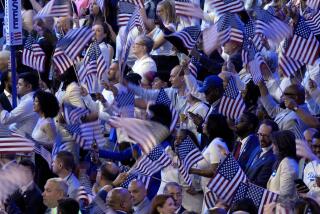Marine at Iwo Jima Recalls Photo as Brush With Fame
- Share via
They say that in the middle of war a dirty weapon is a fighting man’s worst enemy.
Bill Ranous would certainly agree with that.
Ranous missed out on being a part of one of World War II’s most illustrious moments because he was busy cleaning his rifle.
The 21-year-old Los Angeles Marine was in a Pacific island foxhole wiping dirt out of his Browning automatic when his sergeant summoned him and a few others to take a flag to the top of a nearby hill.
“Hold on a minute and let me get my weapon back together,” Ranous said.
The sergeant shook his head. “Never mind. We don’t need that many people,” he replied.
And that’s how Ranous happened to be sitting a few hundred yards away with pieces of his rifle in his lap when his buddies were photographed raising the American flag over Iwo Jima.
The image is considered one of the most powerful pictures of all time. It’s also one of the most controversial.
For years, the Marines were accused by some of posing for the picture. For decades, impostors have tried to claim that they were among the faceless figures straining to hoist the flag over Mt. Suribachi.
But Ranous knows the truth. Because he was there.
Almost.
“At the time, it didn’t mean a thing to any of us,” Ranous said of the flag-raising. “The guys didn’t realize they’d even had their picture taken.”
When the dramatic photograph started popping up in newspapers and posters, the men depicted straining to raise the Stars and Stripes in the middle of a ferocious battle were downright embarrassed, according to Ranous.
“I think everybody felt the same way, that this wasn’t any heroism. They weren’t under heavy fire at the time. It was just a detail they were ordered to do, a job. They just happened to be caught in this great photograph.”
Ranous laughs at those who have falsely claimed that they raised the flag over Iwo Jima.
“Through the years I’ve kept telling myself I’m glad my rifle was dirty and I didn’t have any part of this,” said the 74-year-old retired Pasadena printing salesman.
“Of course, I wonder how much my sales might have improved if I’d been in the picture. I was there, but down below. Deep in my heart I’m kind of glad it came out like it did.”
He is also still amazed, more than a half-century later, that the raising of the flag over Iwo Jima came out like it did.
The battle for the volcanic island 760 miles from Tokyo had been going on for days on Feb. 23, 1945, when a few men from Ranous’ Marine company were sent up the island’s 560-foot Mt. Suribachi to scout out the enemy.
But resistance was surprisingly light. At the top, the Marines hoisted a small, 54-by-28-inch American flag on a piece of pipe.
The sight of the tiny Stars and Stripes was cheered by American forces involved in heavy fighting on the island below. U.S. officials quickly decided to replace the small flag with a larger one.
Another six Marines from Ranous’ squad were dispatched to take a 96-by-56-inch flag up the hill and make the swap. Associated Press photographer Joe Rosenthal and two military cameramen tagged along and reached the top just as Ranous’ friends prepared to lift the pipe and the big flag.
Rosenthal, now a San Francisco resident, managed to swing his boxy Speed Graphic camera around in time to snap one picture as the flag was pushed upright. But he wasn’t certain he had gotten the shot, so he posed a group of Marines around the new flag and photographed them waving and cheering as a backup picture.
Ranous had reassembled his freshly cleaned rifle by the time his buddies came down the hill. One of them, Frank Sousley, joked about posing for the group shot.
“He said, ‘Do you think they’ll print it back home in Kentucky?’ and we all laughed at the publicity hound,” Ranous said.
Both flag-raisings were quickly forgotten in the horror of the days that followed. Sousley and two other men photographed by Rosenthal, Harlon Block of Texas and Mike Strank of Pennsylvania--the sergeant who had asked Ranous to accompany him to the hilltop--were killed.
Ranous was wounded soon after by mortar fire and evacuated by ship to a hospital in Hawaii. That was when he learned that several of his buddies were being portrayed as heroes.
The photo’s three survivors--John Bradley, Rene Gagnon and Ira Hayes--were returned to the United States to promote a war bond drive that featured posters showing the flag-raising.
Ranous has visited the landmark Iwo Jima flag-raising statue in Washington three times.
“The last time I told my wife, Betty Lou, that this is enough, that I don’t want to go back,” Ranous said.
“I don’t want to see it anymore. It eats away at you.”
More to Read
Sign up for Essential California
The most important California stories and recommendations in your inbox every morning.
You may occasionally receive promotional content from the Los Angeles Times.













